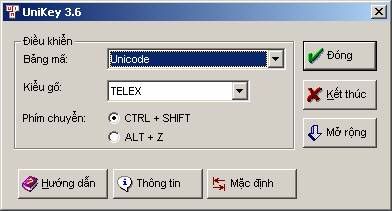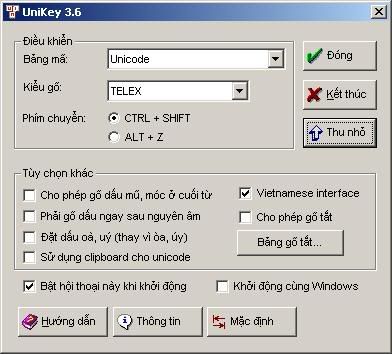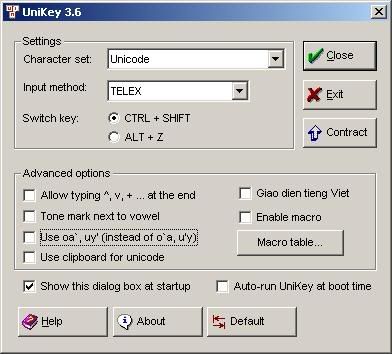Here's the text of the Unikey Help post on the blog Down and Out in Saigon. I've copied it here in case that blog is decommissioned and the information is lost.
I recommend that you use a Vietnamese keyboard or keyboard driver for the task. Despite their name, they are not hardware: they are small programs that sit in your OS and convert your keystrokes into nice, lovely Vietnamese. And do I have a particular program in mind? Boy howdy, I do: Unikey. I've used it for about a year and a half without complaint. I like it so much that I've shut off rival keyboard drivers running on the same machine. The advantages of it are:
- It's free. Nice to know, isn't it?
- It's just a download away: for NT/2000/XP, for 95/98/MEor for Linux.
- Installation is simple: just unzip it and it is ready to go.
- It lacks bloat. It's a small program that does what it is does without any unnecessary feature.
- It sits on the taskbar. This makes it easy to switch between "English" mode and "Vietnamese" mode: just click on the icon on the taskbar.
- The user interface actually provides for English speakers, which makes it easier to understand.
(Of course, if you aren't happy with Unikey, you could look for other utilities. Look at the Vietnamese Unicode FAQs for more information. But rather than comparing all the utilities, I want one that works for me.)
SetupWhen you start up Unikey, you see the following dialogue:
What does it all mean? Fortunately, you can find out what is happening by clicking on the "Mở rộng" button. "Mở rộng" means expand, and that's what you need to do.
See the checkbox with "Vietnamese interface"? Uncheck it. The whole interface will turn into English:
That makes it a lot easier to use, doesn't it? Okay, here's what I recommend you do:
- I recommend you always set the "Character Set" to Unicode - always. A character set is basically how characters like "ư" and "a" are represented as numbers that computers can handle. The Microsoft Office utilities and Blogger are set to handle Unicode by default. Unicode is an international standard, so you can't go much wrong with it. The only exception to this is if you have the misfortune to use one of the old VNI Fonts from years ago. But Unicode - good.
- The "Input method" is what keystrokes will form a character like "ư". I prefer TELEX, but I will give instructions for using Unikey with VNI and VIQR as well. See the next section for instructions.
- Advanced options: uncheck them all. Especially uncheck the "Use oa', uy' (instead of o'a, u'y)". This is an irritating preset that doesn't allow you to write "hoà"; instead it alwayscomes out as "hòa". You don't want that.
- There's also the "Help" button - which provides you "Help" in Vietnamese. If you understand Vietnamese, it's nice to look at. If you don't, it's not of much assistance. Anyway, that's what this document is here for, isn't it?
- Finally, there's "Auto-run UniKey at boot time". If it's your machine, I see no problem with it. If it's someone else's, then I advise against it.
Then click on "Close". The program will now sit on the taskbar - unobtrusive, yet available. If you see a big "V":
That means that it is set up to enter Vietnamese. But if you want to enter pure English, just click on the "V" and you will see:
It's easy to toggle from one to another: left-click on the letter. And if you want to remove the program altogether: right-click on the letter, and on the resulting menu, click "exit".
Okay, now that it is running: what do I do? Reading the next section is a good way to start...
Input MethodsThe idea of a keyboard driver is that it makes it easy to enter desired characters using the keyboard you have. UniKey doesn't even assume you have the "Alt" or "Ctrl" buttons. Instead, you press a combination of letters that tend to follow the following order:
- If you want characters without diacritics, like "a", "b", or "c", then type them.
- If you want characters with diacritics but no tone markers, then type the combination. For example "dd" in TELEX will create a "đ", and "ow" will create a "ơ".
- Always add the tone afterwards.
The following table gives the combinations for all the Vietnamese characters in lower case. If you want upper case, then use upper case letters instead. For example, "DD" in TELEX will create "Đ", and so on. Here are the tables:
Desired letter TELEX VNI VIQR â Type "aa" Type "a6" Type "a^"
ă
Type "aw"
Type "a8"
Type "a("
đ
Type "dd"
Type "d9"
Type "dd"
ê
Type "ee"
Type "e6"
Type "e^"
ô
Type "oo"
Type "o6"
Type "o^"
ơ
Type "ow"
Type "o7"
Type "o+"
ư
Type "w" or "uw"
Type "u7"
Type "u+"
Add a "dấu Sắc"
Type a "s"
Type "1"
Type single quote "'"
Add a "dấu Huyền"
Type a "f"
Type "2"
Type reverse quote "`"
Add a "dấu Hỏi"
Type a "r"
Type "3"
Type "?"
Add a "dấu Ngã"
Type a "x"
Type "4"
Type tilde "~"
Add a "dấu Nặng"
Type a "j"
Type "5"
Type period "."
Remove tone
Type a "z"
Type "0"
Type "0"
To understand this, I will provide some examples:
To Type TELEX VNI VIQR Hai Bà Trưng Type "Hai Baf Trwng" "Hai Ba1 Tru7ng" "Hai Ba` Tru+ng" Tiếng Việt Type "Tieesng Vieejt" Type "Tie61ng Vie65t" Type "Tie^'ng Vie^.t" ĐƯỜNG Type "DDWOWFNG" Type "D9U7O72NG" Type "DDU+O+`NG" Yes, it all seems a little tedious to learn. So choose one of the methods, and practice. I admit you may need a good motivation to do this. My motivations were (a) learning Vietnamese, and (b) retyping the names of Vietnamese students that had been provided sans diacritics.
ConclusionWhat I've tried to do her is set up a tutorial for those unfamiliar with Vietnamese, and also unfamiliar with computers. Alot of this was learnt from consulting the original Vietnamese documentation, and also a lot of practice. Now if you are interested, practice as well. You may still encounter difficulties. For example:
- You are trying to enter Vietnamese in a font that does not have Vietnamese characters. For example, fonts like "Georgia" and "Garamond" do not support them. That's a shame. For the time being, stick with "Arial", "Times New Roman" and "Courier New". There are others.
- You are trying to enter Vietnamese in a pre-UNICODE "Vietnamese" font like VNI-Times. The result looks like poo. One way around it to set the "character set" to "VNI". However, I'd recommend against it, unless (a) you are printing it, or (b) you know the people you are sending the document to also have aVNI-font installed.
- There's one problem that I've had with Excel. You enter a Vietnamese word in a cell. You try to enter another word in another cell. Then the "Auto-complete" feature tries to guess what you are entering, and make a mess of it. This has happened to me a few times. I suggest you turn "Auto-complete" off.
- Finally, the program you are using doesn't support UNICODE at all, and cannot even understand what you are typing. For example, the main interface for the popular editor HTML-Kit cannot handle it.
But if you have a reason to learn Vietnamese, and if you are determined: go for it. I wish you the joy of discovery!
All mistakes in this document are mine.



3 comments:
Very nice .Thank you so much.
I'm looking for instructions to write Vietnamese in Ubuntu and found this link. Very good instructions. Thanks for posting.
You were a lifesaver here- thank you so much!
Post a Comment